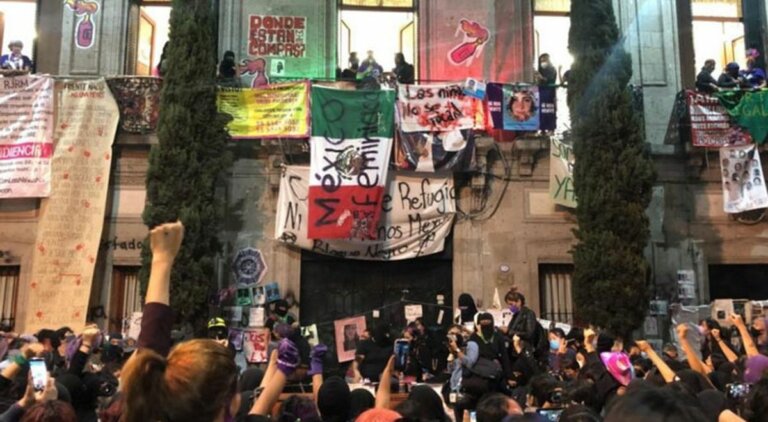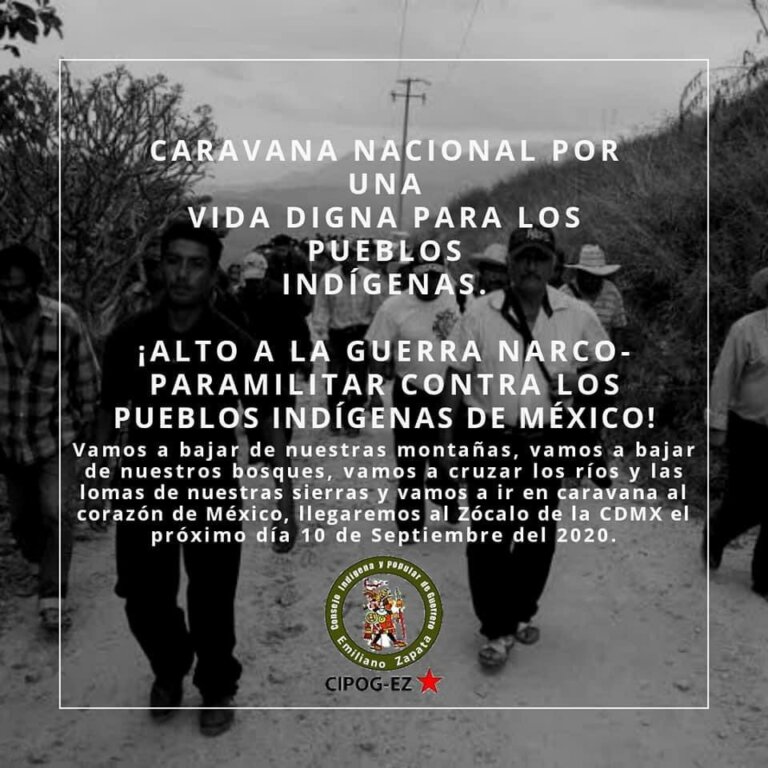Oaxaca is Not Over
August 4th, 2007 – Barucha Calamity Peller writes:
“Don’t let another six months go by before the world turns around and sees Oaxaca again.”
-APPO representative Eric.
Has the world forgotten about Oaxaca?
Political activity, from repression to organizing, is still just as present as when the Oaxaca uprising was visible in the streets, but with the appearance of normalcy in Oaxaca City it seems that many of us have begun the process of forgetting or assuming that the Oaxaca struggle is over.
Walking on the streets of Oaxaca it is indeed hard for the untrained eye to see the continuing struggle for autonomy.
The tourists have returned, the graffiti has been painted over, and the barricades are a burning memory. And perhaps it is a failure that on the left we need dramatic events and repression in order to recognize important political transformation, and in this sense we become part of the dangerous process of forgetting.
But the Oaxaca movement was never defined by the presence of the barricades, by media takeovers, by occupations and sit-ins. Within and without the popular assemblies and the political bodies of the movement the Oaxaca popular rebellion has always been a spirit — something that lives in the conscience of everyone who passes through or has sucked in a breath in Oaxaca.
Some think that the Oaxaca movement grew sick from repression and died, when in fact it continues to live and struggle. Just like the Zapatistas had a long period of silence so has the Oaxaca struggle taken its time to reflect and understand itself, and within the apparent quiet is a storm of organizing and transformation.
Oaxaca is bracing itself for the upcoming state legislative elections on Sunday August 5, which are surrounded by tension. The recent heavy activity of a questionable guerrilla group has only added to the mood. All the while, the APPO continues to change its profile, and the Oaxaca uprising a year later is continues to development into a political force.
The APPO Then, the Many APPOs of Now
This weekend, the 3rd and 4th of August, a large section of the APPO (the Popular Assembly of the People of Oaxaca) is in Mexico City enacting the Popular Political Judgment, bringing forth documentation of repression by the Mexican state to demand punishment for Oaxaca governor Ulises Ruiz and others responsible for the grave human rights abuses in Oaxaca and throughout Mexico.
Meanwhile, the APPO as a political body is split in many directions, and out of this split the process of moving towards autonomy while dissenting with the status quo of the organization of the movement continues. In fact the movement is morphing and turning itself inside out.
The Oaxaca movement from the beginning acted without the direction of the provisional APPO leadership, and many actions, such as the construction of the thousands of barricades in the state capital, Oaxaca City, the radio and television takeovers, and the occupations of public spaces were taken by the people themselves and did not reflect a decision of the APPO.
Until mid-November the APPO was officially defined as a body with representatives from 350 social organizations, many of which were vertical organizations that in of themselves only represented a small section of the Oaxacan people.
The APPO congress in November bought together over 200 representatives from all over the state and the provisional APPO leadership was more or less dissolved. Yet due to the repression in the aftermath of the November 25 street battle between protesters and Preventive Federal Police that led to a siege by federal and state forces on the capital and forced much of the movement to go into hiding, the APPO representatives to the APPO from all over the state have been unable to meet.
Yet the movement has not stopped. The movement has grown and began to spread out, and instead of becoming dispersed it has become more organized within it’s own decentralization.
Although the centralized, almost “formal” APPO of representatives and social organizations still exist, another phenomenon is visible-the ever-increasing number of popular assemblies throughout the capital city and throughout the state. In Oaxaca City there are 71 neighborhood assemblies, calling themselves the APCO (Popular Assemblies of the Colonias de Oaxaca).
Throughout the state the number of local and regional popular assemblies is on the rise, and there have been many new collectives formed everywhere.
Criticisms towards the APPO consejal (the central directed body of representatives) have contributed largely to the decentralized aspect of the movement and have played a large role in the form in which people are reorganizing.
Many sectors of the movement, such as the students, women, youth, neighborhood groups, and even some NGOs, distrust a democratic centralism and became disillusioned with the representative system and demand a collective process. The under representation of many sectors of the APPO has led to the formation of new organizations and collectives who as well as self organizing demand representation and more horizontalism within the APPO consejal.
The localized element of the political formation of the Oaxaca movement has furthered the struggle for autonomy in many senses. Groups who had tactical differences with the provisional leadership of the APPO before are now more self empowered to apply their forms of struggle.
Communities are discussing their own needs in the local assemblies and searching for ways to become more self-sufficient. For instance, some of the neighborhood assemblies are discussing how to begin to have control over means of production to become less reliant on imports, and the discussion over control over agriculture and food production is common.
Given the plurality of the movement there are many debates within the APPO at the moment. Different sectors are split over non-violence vs. direct confrontation with the police, and strategies for getting rid of Governor Ulises Ruiz once and for all and for real social change. Evaluations and criticisms over the best process in which the APPO should have in terms of function and organization continues to have influence in the year-old movement.
The conflict over electoral participation within the APPO has existed for a very long time and created many splits, such as the division in the section 22 teachers union. However it was visible in the APPO congress in November that many people within the movement have no trust in political parties and do not want to enter in the electoral process. There is a side of the APPO that doesn’t seek out a political solution through the electoral process and instead puts its energies into forming assemblies and collectives to work towards autonomy in its own way.
Elections, The APPO, and a Guerilla Group made by the Government?
The elections for the state legislature have historically caused more violence between disputing parts of the population in Oaxaca than any other elections. This time around the elections are especially tense for two reasons: one is that Governor Ulises Ruiz is more desperate than ever to keep a strong representation in the legislature from his party, the PRI (the Revolutionary Institutional Party) which has ruled in Oaxaca for more than seven decades, because of this year’s popular movement to oust him.
The other element adding to the tension is the shadowy EPR (Revolutionary Popular Army). It is feared that an electoral fraud will occur and that the PRI will win the elections and that subsequently severe repression will follow. This is how Ulises Ruiz came to power in 2004. Many of the APPO sympathizers don’t believe in political parties or the electoral process. Nevertheless the elections this weekend are expected to have a big turn out from the movement in which many will vote for the PRD in order to carry through the “punishment vote” against the PRI to further destabilize Ulises Ruiz’s government.
There has also been the worry that the EPR will be used by the state as a reason to postpone the elections.
The guerilla group’s activity has become so heavy in the weeks preceding the elections that many people inside the APPO wonder if the group isn’t a convenient, if not obvious, creation of the state government itself to secure a place in the elections and to justify the further militarization of a turbulent Oaxaca, thus later securing the necessary conditions for corporate investments and the smooth operation of Plan Puebla Panama in the state.
Eight different explosions occurring over the course of five days heavily damaged the Mexican state- oil Pemex’s pipeline and infrastructure in the northern state of Querétaro, far way from Oaxaca, where the EPR is based.
In a communiqué released on July 10th the EPR took responsibility, demanding the physical appearance of Edumundo Reyes Amaya and Gabriel Alberto Cruz. The group claims that the two men, disappeared from Oaxaca City on May 25, are EPR militants being held in a clandestine military prison.
“This is another intention that the state government has-to scare people so that they wont want to change the conditions of the mano duro (hard hand) of the PRI,” said a member of the APPO consejal who wished to remain anonymous. ” This is a typical strategy of the repressive state. I think that the EPR is a creation of the government. They tried it before with an armed group that came out in the north of Oaxaca with new watches and clothes and military haircuts, not at all like guerillas.”
The communiqués are written at times with language similar to the autonomist movement of Oaxaca. Those who believe that the EPR is a government creation also fear that the EPR is being used to finger anarchists and other autonomist sectors within the movement. “It sounds like the discussion that autonomists could have. They want to insert the idea in peoples’ heads that with autonomy comes violence.”
On August 1 two more smaller explosions occurred in the entrance of a Sears store and in front of a bank in Oaxaca City. At first the government accused the APPO, saying the bombs were not typical of the EPR. The EPR later took credit however. Coincidently, the Sears where one of the bombs was placed is also located very close to the Soriana barricade, one of the barricades protecting the university radio, part of the last set of barricades remaining in Oaxaca defended by the neighborhood, anarchists, and the students, all part of the autonomous sector believed to be heavily targeted by the state.
The Real Communist Threat
Throughout the APPO Stalinists from the FPR (Popular Revolutionary Front) party have attempted to appropriate many groups and have deployed themselves strategically throughout the diversity of organizations within the APPO. Again and again the FPR has used the tactic of creating crisis in order to open a space to insert their vanguardism, both in the streets and within APPO organizations. The FPR has fanned so much conflict within the teachers section 22 union that the union has nearly fallen apart and has not been able to meet for months.
COMO, the Oaxaca’s women organization created after the historical takeover of Canal 9 television station on August 1, 2006, has been criticized by many large groups of women who have split off to form their own collectives because of the power that the FPR has sought within COMO.
To Not Forget
The process of forgetting and the appearance of normalcy is exactly what the government wants, both for corporate investments, tourism, and to fight the movement — not only in terms of solidarity and attention, but in terms of creating a perilous psychological space for the movement, where it can be difficult at times to identify with one’s own memories of the movement in the streets, and to deal with the collective trauma of the repression.
With the apparent “normalcy”, from the government to independent media there is a denial of what what continues to be a statewide rebellion. The protesters have been dispersed, businesses have re-opened, and Oaxaca City has returned to the status of a party enclave for Europeans and Americans.
Indeed, the government continues to block the signal of Radio Planton, one of the last remaining Oaxaca radios, and sabotage the Oaxaca Libre independent media page, attempting to do away forever with the voices of the Oaxacan people.
But despite finding itself in this challenging place, the rebellion continues and Oaxaca is still not the same place it was before June of last year. The desperate tactics of the government to hold onto control and militarize the state are signs that the power structures are under grave stress and neo-liberal investments in the state of Oaxaca threatened by a movement that can’t be easily done away with.
Barucha Calamity Peller is a writer and photographer, high school dropout, and rebel rouser. For years she has worked within and reported on Mexican social movements. Oaxaca could not have been reported from the safety of a hotel room, but only from the barricades themselves.
She can be reached by email at macheteyamor@gmail.com
source: http://www.counterpunch.org/


